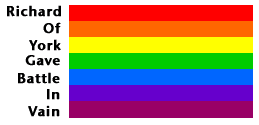Rainbow facts
 Rainbows are beautiful arcs of colour in the sky.
Rainbows are beautiful arcs of colour in the sky.
They occur when it is raining and sunny at the same time.
To see one you have to stand with your back to the sun.
The sun gives off light. The light we can see is called ‘white light’. But this white light isn’t actually white at all, it is made up many different colour wavelengths.
The main colours are red, orange, yellow, green, blue, indigo and violet. These seven colours are called the colours of the spectrum. The longest wavelength is red and the shortest is violet.
 Many people use the phrase ‘Richard Of York Gave Battle In Vain’ to help them remember the colours of the rainbow.
Many people use the phrase ‘Richard Of York Gave Battle In Vain’ to help them remember the colours of the rainbow.
Separating the colours

To separate these seven different colours from the white light, you can use a prism (a triangular-shaped piece of glass).
The prism separates the white light into the different colour wavelengths by bending each light ray at a different angle and so separating the colours. The separation of white light into different colours is called ‘dispersion’. When the prism bends each light ray, this is called ‘refraction’.
So the reason we get rainbows in the sky is because the raindrops act like lots of tiny little prisms. As the sun shines white light through the sky, the raindrops separate it into the seven main colours, forming a rainbow.
Activities
Why not try creating your own phrase to remember the colours of the rainbow?
Why not draw your own rainbow and then colour it in? Try to use the right colours in the right order.
Web page reproduced with the kind permission of the Met Office




